October 10, 2023
The other day, I quite literally felt the weight of my world on my back.
Picture this: I'd just risen from an, ahem, throne session (yes, the toilet), made a beeline for a game of pickleball, took an ambitious lunge, sprinted, and BAM! My back locked up on me.
Now, some might call it a “royal pain,” but this wasn't my first rodeo. Deadlifting mishaps, hoisting heavy objects after prolonged sitting – they've all been culprits in the past.
Anyways, perhaps you have wondered why back pain always happens after trying to engage in something active right after sitting – whether on an airplane, in an office, or – in this case – on a toilet. It's not necessarily because of what often gets blamed: weak low back muscles, a compressed disc, or something seriously wrong with sone kind of medical issue in your back itself, although those factors can certainly contribute and sometimes be the major contributing factor.
Rather, the main issue with low back pain often arises from a combination of notably weak glutes and hamstrings at the back of your legs, paired with tight hip flexors at the front. Especially guilty is the tight psoas or iliacus, muscles that travel upwards in the body and latch onto the pelvic bone.

When these muscles such as the psoas and iliacus (the hip flexors) are tight from being seated or in a cramped position, or they have lots of soft tissue adhesions because they’ve been overexercised and/or not enough soft tissue work has been done on them, and then the back muscles are put under load, cramping and spasming ensue (you may even shed a few tears).
When this happens, some people think they’ve “thrown out their back” or torn a muscle or compressed a disc, but often the pain is simply related to nerve irritation and spasming, which is good news because it means that in many cases, the pain and discomfort can be quickly reversed, often in a matter of minutes, hours or, at the most, days.
But the pain is still annoying and inconvenient. It’s the kind of pain that sidelines workouts, interrupts workdays, and resonates as a nagging throb in your thoughts. But even worse, your body starts taking note. It's not just about the risk of chronic re-injury; instead, your nerves might become edgy, leading to persistent, low-level aches, and persistent guarding and weakening of muscles – unless, that is, you decide to intervene.
Now, like many people, you may consider me a biohacker. And sometimes biohackers get a bad rap because rather than doing the basics like getting enough sunshine, walking barefoot outside, or having a salad, or in the case of back pain, doing lunges, squats, hip flexor stretches, glute strengthening and the like, they go straight to fancy tools like red light therapy, grounding mats, or overpriced supplements. I admit some biohacking can be fringe. Yes, you want to address the basic, foundational aspects of back pain.
I also should say there are already great resources on basic, proven ways to address back pain, like my friend Tim Ferriss' recent interview on scientifically proven modalities of physical therapy exercises and tools – things like quadrupedal exercises where you’re on all fours, doing arm and leg extensions, or Kelly Starret’s famous couch stretch for the hip flexors. This is all fantastic stuff, as is this entire list of articles and podcasts I’ve created in the past for low back pain:
- The #1 Exercise For Low Back Pain, 4 Must-Do Exercises, Biohacking Late Night & Shift Work, Keto To Carnivore Transition & Much More With “The Chosen” Creator Dallas Jenkins.
- 10 Ways To Biohack Back Pain Associated With Exercise (& Why Your Back Gets Injured In The First Place).
- How To Get Extreme “Okinawan” Strength, 3 Ways To Fix Low Back Pain & The Best Core Exercises With Stu McGill.
- How I Healed My Low Back Pain Naturally: Part I.
- How I Healed My Low Back Pain Naturally: Part II.
- How A 6'7″ Tall-Ex-Wall-Street-Trading-Fraternity-Boy-Jock Fixed His Debilitating Back Pain And Naturally Healed His Body.
However, while these foundational principles are pivotal, I now want to let you in on some under-the-radar tools. This is the stuff nobody is talking about. Yes, it’s fringe. Yes, it’s “biohacky.” But trust me, when you combine these insights with the foundational practices, you'll have a highly effective treatment for rapid back pain alleviation – and perhaps more importantly, learn some very good preventive techniques you can use to keep the frustrating issue from happening in the future. And if you're one of those people who appreciate a visual guide, I've also created a comprehensive video that complements this article.
In this case, just a few days after a seriously debilitating low back pain episode – three days, to be precise – these hacks had me back in action, including lifting heavy weights without a trace of any lingering low back pain.
So, brace yourself (pun intended): I’m sharing my top ten biohacks for back pain – all tactics I've personally vetted, vouched for and used on myself and with my clients.
Low Back Pain Biohack #1: Cupping
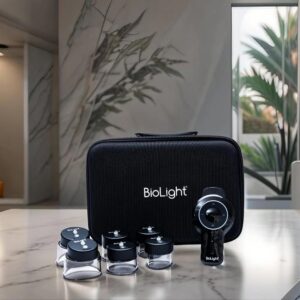 Ever heard of cupping?
Ever heard of cupping?
No, it doesn’t involve drinking. Rather, it's a technique that eases tension in areas prone to spasms or cramps by promoting blood flow.
The BioLight ReVamp Cupping System takes it a notch higher for several key reasons. Unlike other cupping devices, ReVamp integrates near-infrared (NIR) light alongside red light, offering a comprehensive therapy that reaches deep into tissues, including fascia, muscles, tendons, and ligaments. This dual-light approach ensures that you benefit from red light therapy at all tissue levels, providing enhanced muscle recovery, reduced inflammation, pain relief, and improved cellular function. ReVamp's main controller system also eliminates the need for bulky, individual controllers for each cup. This streamlined design allows for more precise cup placement and control over suction intensity. Unlike other products that rely on Bluetooth or Wi-Fi connectivity, ReVamp's independent controller system ensures that you're not exposed to unwanted electromagnetic fields (EMFs), promoting a safer experience.
For optimal benefits, I find myself using the cupping devices around three times a day, each session spanning about 10 minutes. They're designed to be unintrusive; I can even stroll around with them attached. As they compress and release, they not only mimic the therapeutic effects of traditional cupping but also invigorate the area, stimulating healing and enhancing blood flow.
I was literally wearing these bad boys in the morning while walking around my kitchen preparing a smoothie, standing at my standing desk, and even once while driving in my car. They’re versatile, effective, and well worth the mild, red-skin “hickey” they produce.
Low Back Pain Biohack #2: Red Light Therapy
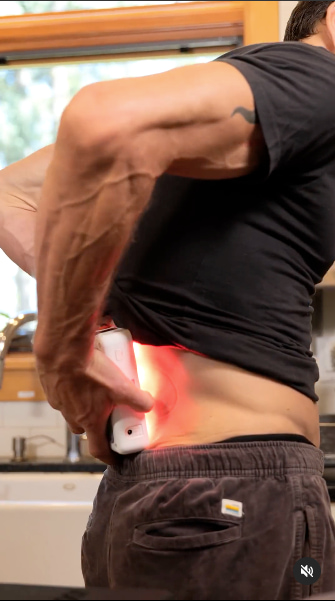 I’ve also found significant low back pain relief using the Joovv Go red light therapy device, particularly at night while lying in bed.
I’ve also found significant low back pain relief using the Joovv Go red light therapy device, particularly at night while lying in bed.
Positioned at the base of my spine while resting in bed, this tool harnesses therapeutic 650-850 nm red light wavelengths, well-known for addressing low back discomfort.
While I own full-body red light panels, the Joovv Go's compactness offers targeted relief, allowing me to focus on specific areas, such as the low back, whether I'm seated or reclining. And, considering the intricate link between hip flexors, psoas, and back pain, it's worth noting the benefits of shining the red light on the hips and front of the legs. This practice further alleviated my symptoms of cramping and spasming post-injury.
Now, a humorous tidbit: there's been some buzz (and chuckles) about my interest in shining laser lights in more personal regions. This chatter might have been sparked by a Men's Health magazine feature where I explored the potential of photobiomodulation (light therapy) for enhancing male sexual health. On multiple podcast episodes, I've candidly shared my routine of basking my nether regions in Joovv's red and near-infrared light for 20-30 minutes daily. But jests aside, the merits of photobiomodulation go beyond intimate care. Intriguingly, there’s even been talk that red light therapy’s myriad benefits might position it close to performance-enhancing drugs.
If you’re keen on delving deeper into red light therapy, I recommend my podcast, “Shining Laser Lights On Your Balls & Beyond: Photobiomodulation 101,” and the article, “The Power Of Photobiomodulation: My Daily Red Light Therapy Routine Explained.“
Low Back Pain Biohack #3: Biobelt
Another therapeutic device I’ve grown quite fond of for relieving back pain is the Biobelt by BioMat.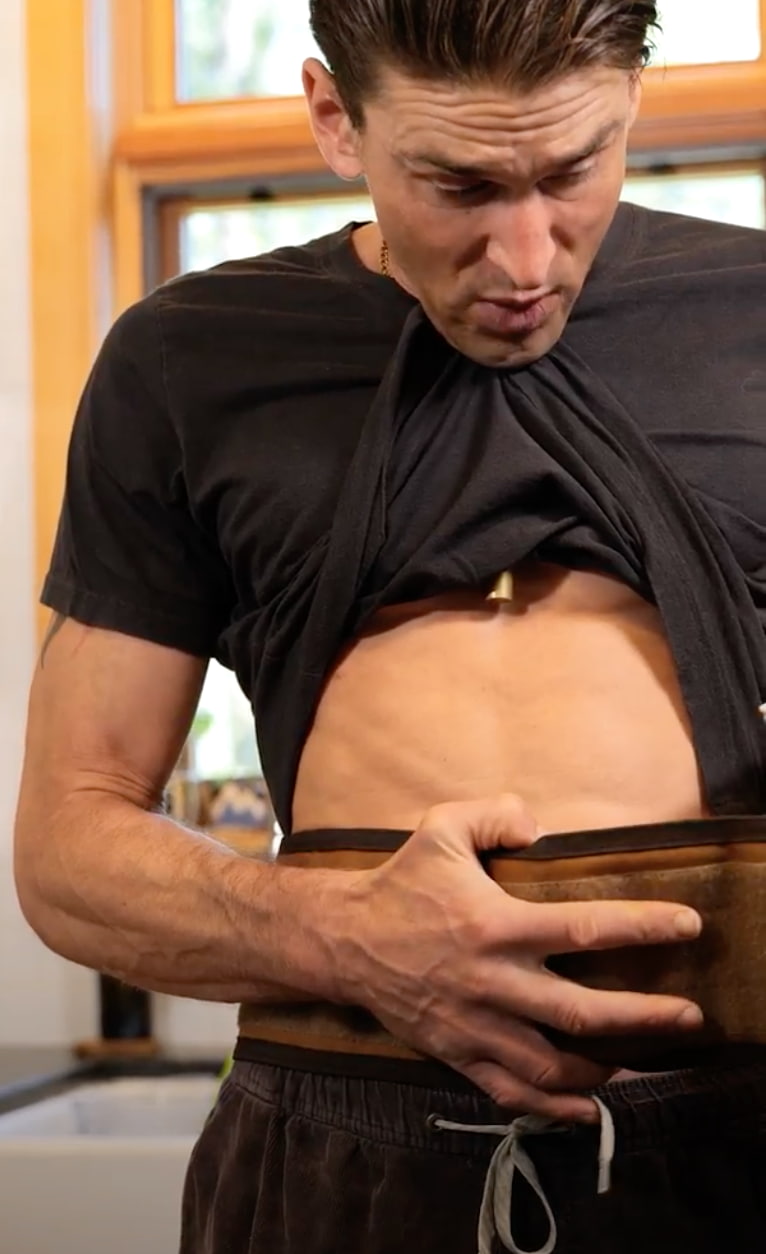
Unlike typical heating pads that might have high EMF concerns, this belt features an attached sponge and is lined with tourmaline and amethyst crystals, known for their grounding and healing properties. Not only does the belt generate a comforting warmth, but it also creates an enveloping electrical sensation.
I often find myself donning the Biobelt at my standing desk, wrapping it around my back for relief. But its benefits aren't just limited to the back. If you're experiencing gut issues, you can just as easily wrap the belt around your front. I tend to crank it up, basking in both its warmth and electrical attributes, which significantly relax my back. What's great is its adaptability.
Despite being corded, the Biobelt is convenient enough for me to plug in and sport throughout my workday. This combination of crystals, warmth, and electricity offers therapeutic effects, allowing my back to rejuvenate even as I focus on tasks.
On a lighter note, if you catch a glimpse of me with the Biobelt, you might think I've discovered the most unfashionable, form-fitting mammoth of a belt ever! But in reality, it’s a part of my “biohacking” arsenal, particularly useful during episodes of gut discomfort or indigestion. Beyond the warmth that feels akin to a gentle hug from a teddy bear, the Biobelt’s infrared capabilities and energy-transmitting stones deeply penetrate the skin, making it an essential tool for gut relief.
Low Back Pain Biohack #4: BetterBack Device
Another one of my go-to tools for optimal back health is the BetterBack device…
…a revolutionary, portable belt that can be used to “teach” your body how to sit properly and to support low back posture.
Simply put, BetterBack transforms any standard chair into a bastion of back support. Whether I'm engrossed in laptop work, savoring a meal, or undertaking other seated activities, this device ensures I maintain posture, keeping me free from slouching and back strain. The stirrups, designed to wrap around the knees, adjust for snugness, guiding the user into an optimal spine-supporting position.
Especially for chairs that might not offer adequate lumbar support, BetterBack is a lifesaver, compact enough to stow in a briefcase or purse, making on-the-move back support a reality.
A bit about BetterBack's inception: A few years back, knee-deep in a tech startup, an unfortunate bout of sciatica introduced its founder, Katherine Krug, to the world of posture awareness. BetterBack’s journey from numerous prototypes to becoming a Kickstarter sensation, crossing the million-dollar mark, and even captivating investors on Shark Tank, speaks volumes about its efficacy.
The positive feedback and consistent ratings on platforms like Amazon highlight its effectiveness. With users in over 110 countries, BetterBack has become a favored choice for many seeking better posture or improved relief from back pain, myself included.
Low Back Pain Biohack #5: Salli Saddle Chair
The Salli Saddle seat stands out as an innovative solution for low back pain.
Its design, inspired by horseback riding saddles, diverges from traditional office chairs that might not always provide the needed support for extended sitting sessions.
Given the challenges posed by conventional chairs – where cramped hip flexors and inactive glutes struggle to support the spine – the Salli chair's split saddle design emerges as a beacon of ergonomic efficiency. When paired with the BetterBack device, it offers an added layer of decompression and posture alignment.
Originating from Finland, Salli Systems has pioneered a holistic approach to sitting health, building furniture that is both ergonomic and functional. Their extensive research and insights not only guide product development but also inform you to make the most of this novel sitting concept. The inventor, Veli-Jussi “Vessi” Jalkanen, has even been a previous podcast guest of mine, and shared this and many other crazy inventive tools from his warehouse when we had a fascinating chat.
Notably, it has shown potential in remedying advanced issues like posture deviations and low back problems. Given its merits, integrating the Salli sitting approach is particularly beneficial for the younger demographic, helping them sidestep common posture and back challenges.
Also, if you've ever wondered about the profound impact furniture can have on your movement and health, definitely take a listen to last week's fascinating podcast episode with Katy Bowman called Why You Should Try Sleeping On The Floor, The “Furniture-Free” Home, Building A Better Butt, Smartphone Solutions & More With Katy Bowman.
Low Back Pain Biohack #6: Anthros Office Chair
Next up is the Anthros office chair – an innovative addition to my personal setup and a marvel of ergonomic design.
This chair, like the Salli Saddle, also has an interesting origin story: At industry trade shows, a comment kept resounding among a team of wheelchair seating experts, which included clinicians, product designers, and marketing executives. They'd frequently hear, “I wish my office chair felt like this!” The team, composed of physical and occupational therapists, seating technicians, and even gamers, primarily catered to wheelchair users, the most vulnerable sitting population. But it led to a broader realization: “What about the rest of the world?”
Drawing from their extensive experience in designing medical seating for wheelchair users, the Anthros team conceived a chair with a unique selling point – an independently adjustable two-part back system. This design, formulated to accommodate the vast differences in human spines, wasn't merely conceptualized on a whim. It was the product of a meticulous meta-analysis of sitting research coupled with an in-depth grasp of biomechanical principles governing sitting postures.
Back in my workspace, the Anthros office chair's impact is palpable. Its adjustable supports sync harmoniously with the spine's natural curve. The slidable back piece? Nothing short of revolutionary, allowing me to pinpoint the perfect lumbar support position. Whether I'm working, dining, or conversing, an upright, 90-degree posture has become second nature.
On days when I need that extra spine alignment, I pair this chair with the BetterBack device, maximizing decompression and posture maintenance. Investing in the Anthros chair is an investment in a future free from low back issues.
Low Back Pain Biohack #7: PEMF
PEMF (pulsed electromagnetic fields) mirror the Earth's natural electromagnetic pulse, resonating at 7.8 hertz. This pulsation, coupled with frequent global lightning strikes, forms the planet's life-sustaining energy matrix. Similarly, your body functions electromagnetically, with your brain orchestrating every system via electromagnetic signals. When your cells are electrically charged, they possess a remarkable healing ability.
If you're acquainted with the principles of grounding or earthing, this science may sound familiar. I discussed it in detail in a podcast episode titled “The Myth About “Grounding”, Acupuncture Without Needles, 400% Increase In Stem Cell Production & Much More,” shedding light on the transformative effects of reconnecting with Earth's energy.
I’d also recommend tuning into my conversation with Clint Ober in the episode “My New #1 Hack For Zapping Inflammation, Increasing Deep Sleep & Recovering Faster – Earthing (The Most Important Health Discovery Ever?).” Clint and I discuss the myriad benefits of grounding, and I also provide links to over 20 peer-reviewed research studies on the subject, showcasing the incredible healing potential of both grounding and PEMF.
Examples of portable, user-friendly PEMF devices that can be placed on or near your body to alleviate back pain include CELLER8, IcesM1, and Flexpulse, while the BioBalance mat, Biomat, HigherDOSE mat, and the Ground Therapy Sleep Mat from Ultimate Longevity are full-body devices that can be placed under your top sheet to operate the entire night.
Low Back Pain Biohack #8: BPC-157 Peptide
Originally used for gastrointestinal issues, the peptide BPC-157 has anti-inflammatory effects throughout the body.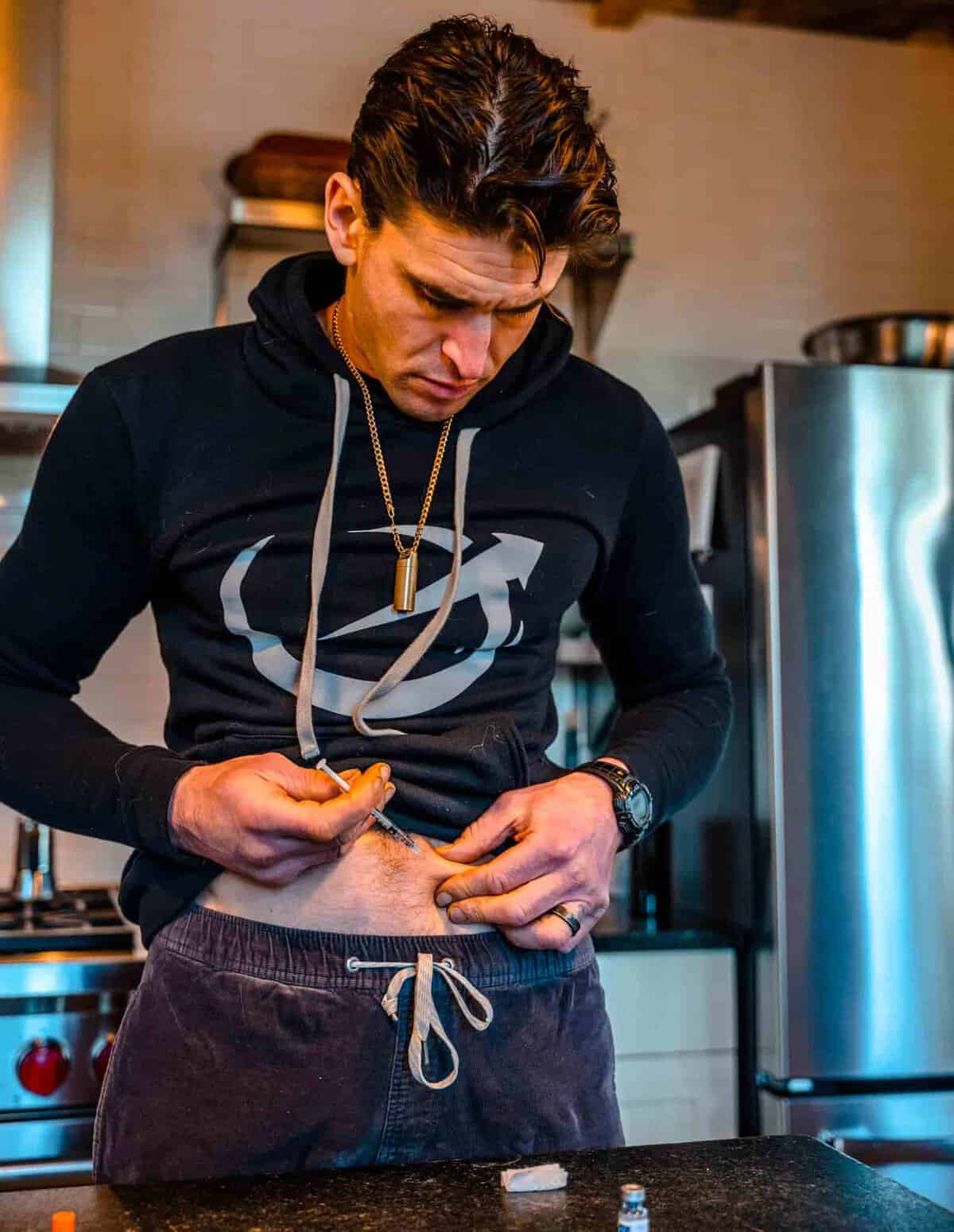
In my opinion, it's far safer than ibuprofen for organs like the liver and kidneys.
Quick review: a peptide is a sequence of amino acids. Specifically, a chain of two or more amino acids, intricately bonded in a specific manner. Originally designed to address gastrointestinal issues, BPC-157 has showcased its proficiency in exerting anti-inflammatory effects throughout the body.
You can inject BPC-157 near an injury site, however, the FDA has cracked down on injectable BPC-157. Here’s the cool thing, though: this peptide is bioavailable when swallowed. One of my favorite companies for orally bioavailable peptides is LVLUP Health (use code BEN to save 10%).
Personally, I've found the oral BPC-157 peptide to be a remarkable ally in fast-tracking injury recovery, especially when dealing with low back concerns. It plays a dual role: curtailing inflammation and assisting the healing of damaged tissue.
If you’re interested in learning more about the fascinating world of BPC-157, I highly recommend checking out my article “How To Use BPC-157: A Complete Dummies Guide To Healing The Body Like Wolverine” and my podcast with Kyal Van Der Leest, “A Done-For-You ‘Shotgun’ Formula For Fixing Your Digestion (The Gut Repair Formula), Oral Peptides, Mold & More With LVLUP Health’s Kyal Van Der Leest.”
I've also crafted a one-stop-shop resource page for you where you can find all my info on peptides, from articles to podcast episodes, since I've crafted and produced a lot of content surrounding peptides through the years. You'll find many of my favorites there, like LVLUP Health, Limitless Nootropics, Peptides Sciences, and more.
Low Back Pain Biohack #9: Magnesium
Magnesium, while not solely directed for inflammation or injury, serves a vital role as a muscle relaxant in my regimen.
On a regular day, I consume magnesium before hitting the sack. However, in instances of low back pain, I increase the intake, consuming 8-12 capsules.
The rationale for my higher dose is multifaceted. Firstly, magnesium acts as a stool softener and a gentle laxative. An injured back can make toilet visits an ordeal, particularly when the hip flexors and glutes are tense and less responsive. The less time spent on the toilet, the less strain on the back. Using tools like the Squatty Potty aids in maintaining an ideal posture, but magnesium ensures efficiency by softening stools, thus minimizing the risk of back aggravation.
Magnesium's benefits aren't just restricted to muscle relaxation. In my article “How To Get Rid Of A Magnesium Deficiency – The Ultimate Guide,” I talk about how a lack of magnesium can lead to muscle cramps, increased soreness, reduced force generation, hindered recovery and sleep, weakened immunity, and even severe heart issues during intense physical activity. Research emphasizes magnesium's role in buffering lactic acid, boosting oxygen uptake and overall work output, and enhancing cardiovascular efficiency.
Furthermore, magnesium supplementation has shown the potential to elevate testosterone levels and fortify muscle strength by up to 30%. It's a vital mineral, playing a crucial role in myriad bodily processes – and definitely worth adding to your toolkit for reducing low back pain.
As an FYI in terms of dosage, they vary depending on what I'm using the magnesium for. For pain, recovery, and muscle spasms or cramping I'm a fan of 300-500mg—this also goes for bowel tolerance, and often before bed due to the relaxing effects. A few of my favorite magnesium brands include:
- BiOptimizers Magnesium Breakthrough
- Jigsaw Health
- Enviromedica (also want to specifically shout out their transdermal magnesium products—their bathflakes, lotion, and oil, all infused with magnesium!).
- Upgraded Formulas Magnesium
Low Back Pain Biohack #10: BrainTap
John Sarno, MD, the author of The MindBody Prescription, talks about how much low back pain can actually stem from mental and psychological factors.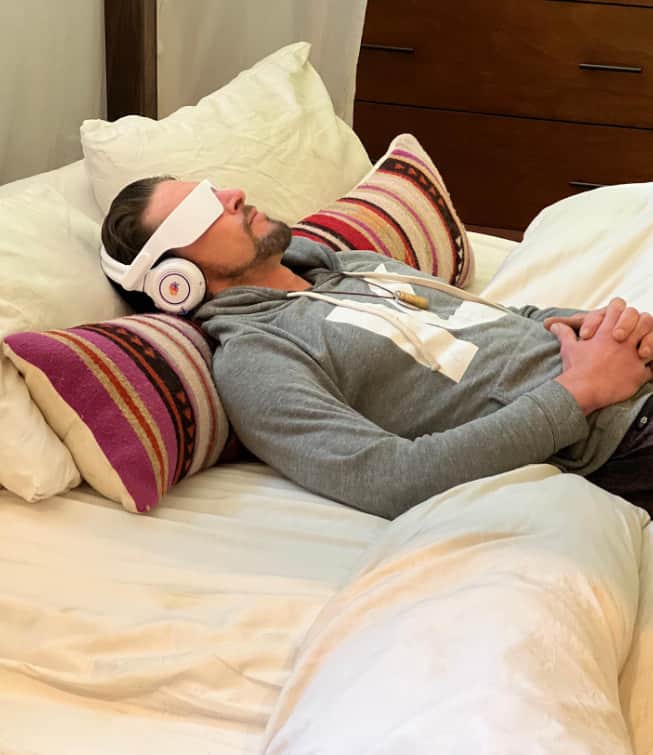
And after you've injured your back a few times, your back just begins to be something that you associate with pain.
The BrainTap device has programs designed to reprogram your brain to reduce pain perceptions. There's a whole “Get Rid of Your Pain” audio series that helps shut off those associative pain pathways, even when your back is no longer injured. It helps eliminate the “ghost” pain that lingers psychologically.
Generally, I'm not very hypnotizable – but a highly effective way I've been able to hypnotize myself is via light and sound stimulation, using the Brain Tap,
Unlike other modalities that might limit themselves to specific brainwave patterns, BrainTap covers a broad spectrum, ensuring a comprehensive brainwave experience. The device's light pulses, channeled through ear meridians and the retina, create a direct, rejuvenating pathway to the brain, achieving states often reserved for seasoned meditation practitioners. Through BrainTap, not only can you alleviate the pain associations, but you also attain balanced brain fitness, boosting clarity, focus, and resilience.
My podcast “How To Fast Track Your Way To Optimized Brain Fitness” with Dr. Patrick Porter of BrainTap offers more invaluable insights on the brain/pain connection. Beyond pain management, the BrainTap is my go-to for achieving states of relaxation, making it an indispensable tool for stress relief, airplane rest, and rejuvenating naps. You'll even find meditation sessions from yours truly programmed into the device
Summary
As you probably know, pain can often feel like an insurmountable hurdle that you just can't solve, but with the right tools, it's a challenge you can overcome.
Bear in mind, I'm not saying that you need to rush out and spend thousands of dollars to have all of these tools in your own home. But hopefully, these biohacking ideas give you new options beyond conventional physical therapy to manage back pain and, if you desire, to heal as fast as possible and bounce back stronger than ever using new technologies and modalities that – sure – a physical therapist might chuckle at, but subjectively, have worked very well for me and my clients. Even just incorporating one or two of these biohacks, tools, or technologies can get you on the road to recovery faster.
In summary, here’s a recap of my top 10 biohacks for low back pain:
- Cupping: Harnessing the ancient art of suction, cupping works wonders in relieving muscle tension, increasing blood flow, and creating a therapeutic release that can speed up recovery.
- Red Light Therapy (Joovv Go): Delve into the rejuvenating world of Joovv Go's Red Light Therapy to target specific pain points, using 650-820 nm wavelengths, and paving the way for faster back pain relief.
- Biobelt: More than just warmth, the Biobelt brings together amethyst crystals and grounding energy, providing back relief and comfort for gastrointestinal challenges.
- BetterBack: A simple yet revolutionary approach to posture, the BetterBack device transforms any seat into an ergonomic haven, guiding your spine into its natural alignment.
- Salli Saddle: Redefining the way you sit, the Salli Saddle chair, inspired by equestrian design, emphasizes ergonomic support, particularly benefiting the spine.
- Anthros: More than just a chair, Anthros offers meticulously crafted lumbar support, allowing you to hone your posture and keep your back in check, especially during long working hours.
- Pulse PEMF Device: By utilizing pulsed electromagnetic fields, this device assists in muscle relaxation, optimizing blood flow, and aiding in the speedy recovery of back ailments.
- BPC-157: Beyond conventional medicine, BPC-157, a peptide sequence, offers anti-inflammatory effects that can be a boon for back pain sufferers, whether taken orally or injected.
- Magnesium: A simple mineral with profound effects, magnesium acts as a natural muscle relaxant, with the added benefit of softening stools, reducing strain on your back.
- BrainTap Device: Venturing into the mind-body connection, the BrainTap device employs light and sound stimulation to retrain the brain, addressing the psychological elements of pain, and offering a refreshing mental respite.
Pairing foundational approaches with these unconventional biohacks can lead to a more holistic, swift recovery. And, if you want to see them in action, definitely watch my detailed video walkthrough below.
What questions do you have for me about biohacking low back pain? Leave them below – I’ve got your back :) with answers!

